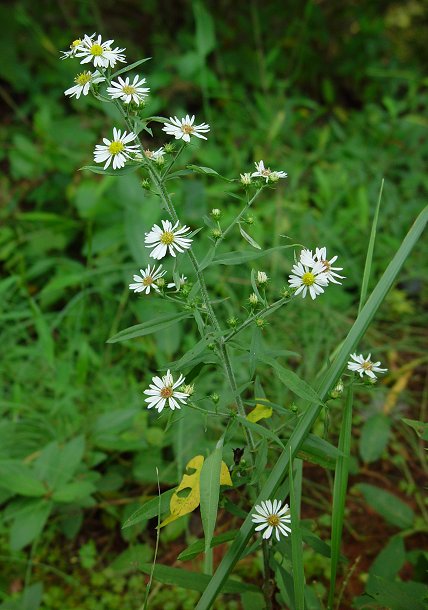Symphyotrichum pilosum (Willd.) G.L. Nesom
White Heath Aster, Hairy White Oldfield Aster

Native
CC = 0
CW = 0
MOC = 99
© DETenaglia
Symphyotrichum pilosum (Willd.) G.L. NesomWhite Heath Aster, Hairy White Oldfield Aster | |
 |
Native CC = 0 CW = 0 MOC = 99 |
© DETenaglia |
|
Family - Asteraceae/Astereae Habit - Perennial forb with a short, stout, somewhat woody rootstock, sometimes also with stout, somewhat succulent rhizomes. Stems - Ascending to erect, to 1.5 m, single or multiple from the base, branching upward, glabrous or sparsely to densely pubescent with short, spreading and/or curved hairs, more densely so toward the tip, the hairs usually relatively evenly distributed, occasionally in longitudinal lines.
Leaves - Alternate, simple, petiolate to sessile upward. Offshoots sometimes present. Basal and/or lower stem leaves usually absent from the flowering stems, sessile or with a short, poorly differentiated petiole, the blade 4-8 cm long, 1.0-2.5 cm wide, oblanceolate to obovate, tapered at the base, rounded or angled to a usually bluntly pointed tip, the margins usually with spreading hairs and entire or with sparse, blunt, shallow teeth, the surfaces glabrous or the upper surface sparsely to moderately roughened with short, stiff hairs, the secondary veins on the leaf undersurface often faint and difficult to distinguish from the veinlets, these forming an irregular network of relatively short areoles. Median and upper stem leaves progressively smaller, the larger ones often withered by flowering time, sessile, the base sometimes slightly expanded but not clasping the stem, the blades 1-10 cm long, linear to less commonly elliptic-lanceolate or oblanceolate, the margins entire or shallowly toothed, tapered at the base, angled or tapered to a sharply pointed tip (often with a short, hard point at the tip), the veinlets usually relatively easily observed, otherwise similar to the lower stem leaves.
Inflorescence - Paniculate arrangement of flower heads, consisting of commonly relatively long, loosely ascending to spreading, racemose branches, sometimes reduced to a solitary raceme, the heads appearing mostly long-stalked and oriented upward, the bracts along the ultimate branches 0.2-1.0 cm long, relatively numerous, leaflike, linear, noticeably shorter and often narrower than the adjacent foliage leaves. Heads - Radiate, mostly 1.4-2.0 cm in diameter. Involucre 4-8 mm long, urn-shaped to more or less cup-shaped, the bracts in 4-6 unequal, overlapping series. Involucral bracts narrowly oblong-oblanceolate, at least the outer few series somewhat inrolled, thickened, and tapered at the sharply pointed, usually awl-shaped tip, with a white to yellowish-or purplish-tinged, spinelike point at the very tip, the tip ascending or somewhat outward-then upward-curved, the surfaces glabrous or the outer surface sparsely hairy, the margins minutely toothed or somewhat irregular and often sparsely short-hairy. Receptacle flat, naked.
Flowers - Ray florets pistillate, 15-35 per head, in usually 1 or 2 series, the corollas well developed, 5-10 mm long, white. Disc florets perfect, 20-40 per head, the corollas 2.5-5.0 mm long, the slender portion of the tube noticeably shorter than the slightly expanded apical portion, the lobes 0.5-0.9 mm long, 22-30 percent of the total length of the expanded portion. Pappus bristles 2.5-5.0 mm long, white.
Fruits - Achenes 1.0-1.5 mm long, with 3-4 longitudinal ribs, pale gray to tan, moderately hairy, the hairs lacking swollen bases. Flowering - August - November. Habitat - Prairies, glades, forests, savannas, streambanks, pond margins, fields, pastures, fencerows, gardens, railroads, roadsides, open disturbed areas. Origin - Native to the U.S. Lookalikes - Several other members of the genus, including S. lateriflorum, S. ontarionis, S. subulatum, and others. Other info. - This highly variable species is common and found throughout Missouri. It is one of the most common species of Symphyotrichum, also found throughout the eastern U.S. The plant is highly variable in leaf shape and stem pubescence, the latter ranging from glabrous to densely hirsute. The inrolled, sharp tips of the involucral bracts are a key characteristic for field identification (though not unique to this species). The small white asters are troublesome enough to identify confidently, and the variability seen in this species contributes to this difficulty. The species apparently exists as a polyploid complex, and there is also indication that some of the morphological variability is due to environmental influences and does not reflect genetic differences. Numerous infraspecific designations have been used to accommodate the variability, but these are not uniformly accepted. Yatskievych declined to recognize infraspecific forms in Missouri, pending further clarification of the complex. Photographs taken in Brown Summit, NC., 10-3-02 (DETenaglia). |